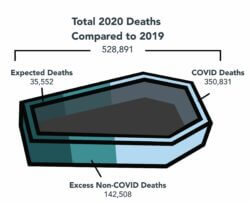February 24, 2022

Death Math
Many analysts are using “excess deaths” as a proxy for COVID deaths during the pandemic. It’s not that simple. Excess deaths is a statistical measure of observed versus expected deaths for a specific time period.
Year-to-year deaths closely follow historical trends. For example, there were only 15,633 in 2019 relative to 2018 (2,854,838 vs. 2,839,205). However, year-to-year deaths skyrocketed to 528,891 in 2020. [1] To shape the America’s post-pandemic public-health policies, we must understand COVID’s precise role in the deaths of more than half a million Americans.
The National Center for Health Statistics (NCHS) compiles the government’s births, deaths, and diseases database. NCHS uses death certificates in the 50 states and DC to tabulate its statistics for the numbers and causes of death, so each death traces to a specific person from a specific place with a specified cause of death.
Death numbers are impossible to fake but are open to interpretation. That’s where the political debate becomes heated. The politization of pandemic’s death counts has produced doubt, division, and denial. A close examination of the 2020 death data clarifies what actually did and did not happen in 2020. It also raises profound health policy questions regarding strategies for minimizing excess deaths going forward.
Excess Deaths In America During 2020
Total deaths grew from 2,854,838 in 2019 to 3,383,729 in 2020. Statistically, deaths increase each year as population grows and due to underlying trends such as rising drug overdoses. To account for this, I’m attributing 35,552 as incremental excess deaths accounting for historical trends. [2] Consequently, unexplained excess deaths in 2020 were 493,339 (528,891-35,552), or just under half a million.
Even in 2020, heart disease and cancer were still the leading causes of death. COVID was number three on the list, followed by unintentional injury and stroke. Particularly surprising is that fact that of the Ten Leading Causes of Death, only kidney disease and lower respiratory disease did not have significant increases. While COVID was the major contributor to the 2020 outsized increases in deaths, other causes were also contributors.
The NCHS recorded 350,831 COVID U.S. deaths in 2020. This means there were still 142,508 excess non-COVID US deaths. In other words, something other than COVID caused nearly 29 percent of the excess deaths. These non-COVID excess deaths should be dead center in our public policy debates about pandemics and mitigation strategies.
The number of deaths caused by COVID is a subject of intense debate. However, just calling the numbers “fake” is not an argument. Let’s look at the principal arguments by those seeking to diminish COVID’s impact on public health.
“It’s just the flu.” This argument is pretty easy to address. If COVID is “just the flu,” it produced at least 350 thousand more deaths than the previous year. The same mitigation strategies would have been employed against a pandemic flu outbreak, so not much would be different in our social and economic landscape. The more insidious side of this argument is to cast doubt on the efficacy of the COVID vaccines. If it is “just the flu,” then COVID vaccines are unnecessary and not beneficial. There were no COVID vaccines in 2020, so it will be a year before the death statistics demonstrate the efficacy of the COVID vaccines. Other sources exist to make this point, but let’s stick to the Death Math for now.
“Where did the flu go?” This argument has two aspects to it. The first is the casual empiricism of not having contact or conversation with someone who has had the flu and the overwhelming messaging on COVID. If COVID is all one hears about, then the flu seems to disappear — especially in the absence of trusted empirical data. The second is a claim that deaths from influenza fed into COVID numbers for economic reasons as reimbursement for COVID treatment is higher than that for influenza. If this argument were valid, we would expect a substantial drop in recorded influenza deaths. Instead, deaths from influenza and pneumonia increased in 2020. Unfortunately, NCHS classifies influenza and pneumonia together as a cause of death. While both COVID and flu can both result in pneumonia, the whole category increased rather than having a sharp decrease due to deliberate miscoding of the cause of death.
There’s no informed, substantive argument to suggest that the COVID death count is “wrong.” In fact, there’s reason to believe that deaths may have been undercounted, especially in the early days of the pandemic. There’s a false precision in specifying exactly 350,831 COVID deaths, because surely there’s some noise in the numbers. However, it’s safe to say over 350,000 US residents died of COVID in 2020.

The pandemic accounts for most of 2020’s excess deaths through COVID and its residual impact. Skeptics of pandemic mitigation measures will seize on the excess non-COVID deaths as the collateral damage of “lockdowns.” We shouldn’t dismiss that point of view out of hand. Many factors contributed to the non-COVID deaths, and certainly isolation, despair and loneliness are among them.
Critical Questions
We will not fully understand the causes of the non-COVID excess deaths for years, but now is the time to put the questions in front of our elected officials.
How many of the excess deaths are a consequence of low performing local healthcare? The pandemic has laid bare the inequities and imbalances in many aspects of our society, particularly healthcare. COVID has been a vicious killer in communities with poorer-performing health systems and with lower overall health status. Further research will likely demonstrate excess non-COVID deaths were concentrated in these communities. Were the excess deaths in heart disease and diabetes caused by people unable to get care or because they had a tenuous connection to the health system and other support systems that the pandemic severed? Or was it because there was no safe way to get care that is already difficult to access?
 How many of the excess deaths were caused by mitigation efforts? This question should be tackled in a clear, rational manner. There will be no public confidence in current or future mitigation efforts without the science and public policy recognizing that those strategies, especially lockdowns, have costs. Clearly isolation and loneliness contributed to deaths. Loss of transportation to healthcare, or loss of a livelihood, must have impacted the excess deaths. There’s no truthful discussion of the benefits of mitigation strategies without acknowledging the cost.
How many of the excess deaths were caused by mitigation efforts? This question should be tackled in a clear, rational manner. There will be no public confidence in current or future mitigation efforts without the science and public policy recognizing that those strategies, especially lockdowns, have costs. Clearly isolation and loneliness contributed to deaths. Loss of transportation to healthcare, or loss of a livelihood, must have impacted the excess deaths. There’s no truthful discussion of the benefits of mitigation strategies without acknowledging the cost.
How many of the excess deaths have no bearing on the pandemic? It would be easy, and likely a mistake, to blame increases in death due to homicide, suicide, and drug and alcohol use on the pandemic. All these causes of death were on the rise prior to the emergence of COVID-19. For instance, the tsunami of fentanyl coming into the US was more of a contributor to overdose deaths than the pandemic. The pandemic should not obscure the increasing rise in “deaths of despair” or serve as an excuse to slow policies to counter them.
What are the objectives of mitigation strategies? The objectives of the most ardent proponents of closures and other lockdown strategies have drifted from “bend the curve” to “zero COVID.” This drift has been most evident in public schools where administrators, parent, teachers, and teachers’ unions have vastly different understandings of the objectives of school closures and masks, and the objectives keep changing. Understanding the objectives gives the public an opportunity to weigh the benefits of mitigation strategies against their costs. It could also create a consensus as to when the measures can cease.
Conclusion: Excess Death Ambiguity
The public release of the 2020 death statistics has opened yet another window on the pandemic. Neither side in the public debate over the pandemic and public interventions should feel vindicated. The numbers prove conclusively that COVID is a savage, implacable killer. However, the numbers also show that excess deaths occurred outside of the disease, some likely caused by attempts to slow and contain its spread.
The 2020 death data, along with the relevant economic data, quantify the pandemic in human and monetary costs. The data will allow our elected officials to make more informed and selective decisions in the future regarding efforts to suppress a disease outbreak.
Good, reliable data is the basis for good public policy. However, the calculus of trade-offs works best when full information is available.
The New York Times claims that the CDC is withholding valuable data from the public and from policy officials. [3] A spokesperson for the CDC explained that the data aren’t “ready for prime time” and that the data may be “misinterpreted.” This is outrageous, irresponsible, and arrogant.
According to the New York Times, “Much of the withheld information could help state and local health officials better target their efforts to bring the virus under control.” Elected officials in this country still face a steep learning curve, but they can only succeed in Death Math Class with a full textbook.
Sources
- Unless noted otherwise all statistics are derived from available public information at the National Center for Health Statistics.
- I used the simple mean of the differences for total year over year deaths from 2015, not including 2020.
- https://www.nytimes.com/2022/02/20/health/covid-cdc-data.html
Read Other Articles From Kerry Weems
- February 2021: What to Expect When You’re Expecting (A Budget)
- December 2020: Failing at Drug Price Reform
- November 2020: A Stalled Transition: Won’t Derail Biden’s Healthcare Team
- September 2020: A Pandemic Induced Collapse of the Way We Pay for Healthcare
- July 2020: Pandemic Preparedness: Beyond Bioterrorism & Federalism
- May 2020: Understanding Despair, Capture and Profiteering in American Healthcare
- February 2020: Advancing Advance Care Plans through Medicare: It’s Time to Move





